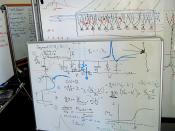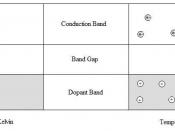GCSE Physics Coursework - Resistance of a Wire Coursework
Resistance of a Wire
Task
To investigate how the resistance of a wire is affected by the length of the wire.
Theory
What is resistance?
Electricity is conducted through a conductor, in this case wire, by means of free electrons. The number of free electrons depends on the material and more free electrons means a better conductor, i.e. it has less resistance. For example, gold has more free electrons than iron and, as a result, it is a better conductor. The free electrons are given energy and as a result move and collide with neighbouring free electrons. This happens across the length of the wire and thus electricity is conducted. Resistance is the result of energy loss as heat. It involves collisions between the free electrons and the fixed particles of the metal, other free electrons and impurities. These collisions convert some of the energy that the free electrons are carrying into heat.
How is it measured?
The resistance of a length of wire is calculated by measuring the current present in the circuit (in series) and the voltage across the wire (in parallel). These measurements are then applied to this formula:
V = I âÃÂ¥ R where V = Voltage, I = Current and R = Resistance
This can be rearranged to:
R = V
I
Ohm's Law
It is also relevant to know of Ohm's Law, which states that the current through a metallic conductor (e.g. wire) at a constant temperature is proportional to the potential difference (voltage). Therefore V âì I is constant. This means that the resistance of a metallic conductor is constant providing that the temperature also remains constant. Furthermore, the resistance of a metal increases as its temperature increases. This is because at higher...


